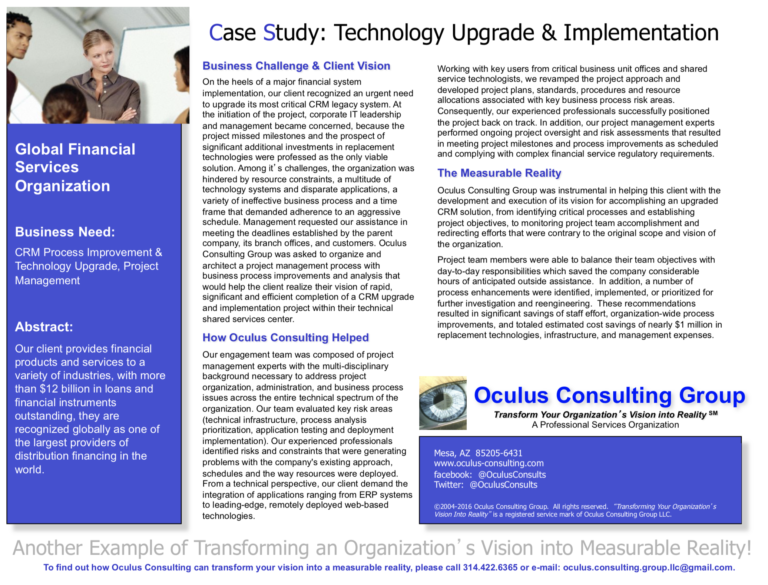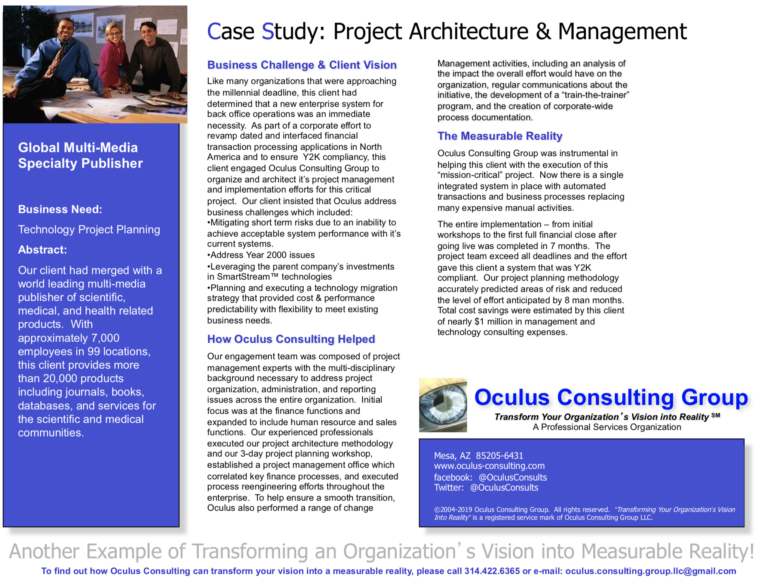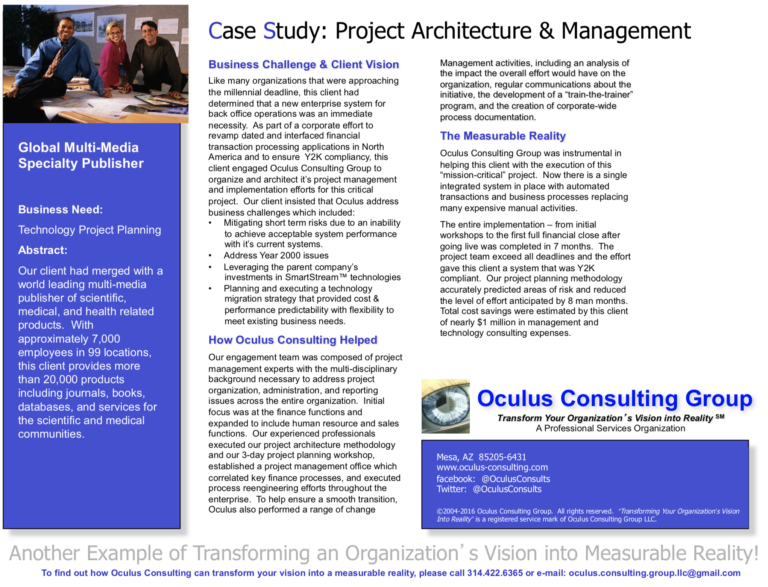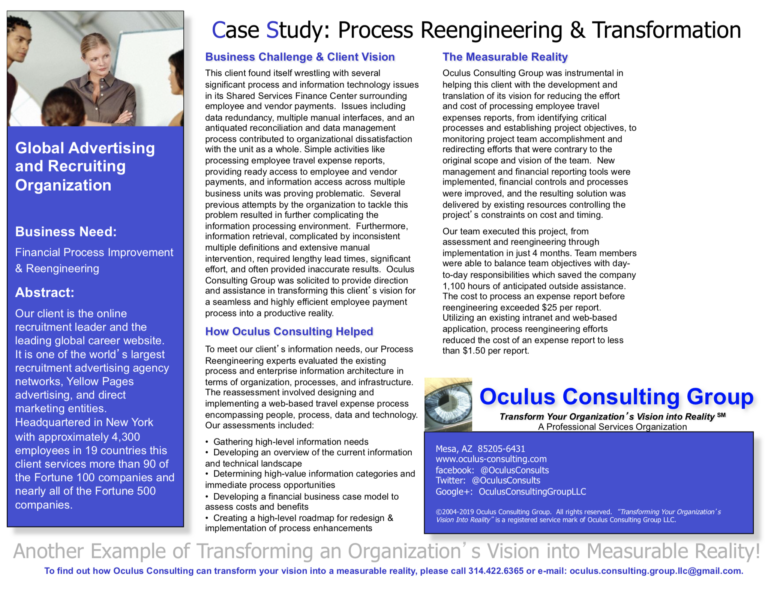Maintaining an Enterprise Focus with Breakthrough Technologies
Whether your organization is revisiting generic solution implementations, or exploring one of today’s innovative technologies, the key to creating and ensuring a process orientation in the technology implementation – and information-oriented processes – will be essential for an effective implementation

By Oculus Consulting Group LLC
What do artificial intelligence, blockchain utilization, network security, mobility solutions, big data, and the internet of things have in common with each other and with your enterprise? Let’s explore just two of these opportunities that might be facing your organization.
Consider that artificial intelligence has so far been mainly the plaything of big tech companies like Amazon, Baidu, Google, and Microsoft, as well as some startups. For many other organizations and parts of the economy, AI systems are too expensive and too difficult to implement fully. But as MIT reports, that constraint is changing rapidly. What’s the change in the solution? Machine-learning tools based in the cloud are bringing AI to a far broader audience. Currently, AI is used mostly in the software and technology industries, where it has created efficiencies and produced new products and services. Many other businesses and industries have struggled to take advantage of the advances in artificial intelligence. Sectors such as medicine, manufacturing, education, and energy could also be transformed if they were able to implement the technology more fully, with a huge boost to economic productivity. Most companies, though, still don’t have enough people who know how to use cloud AI.
Likewise, true internet privacy could finally become possible thanks to a new tool that can — for instance — let you prove you’re over 18 without revealing your date of birth, or prove you have enough money in the bank for a financial transaction without revealing your account balance or other details. That limits the risk of a privacy breach or identity theft. The tool is an emerging cryptographic protocol called zero-knowledge proof. Though researchers have worked on it for decades, interest has exploded in the past year, thanks in part to the growing obsession with cryptocurrencies, most of which aren’t private.
“Regardless of the new technology that you believe is paramount for the success of your organization, these systems and technologies will pass information freely across your organization’s key business functions.”
So back to our original question, what do these blockbuster new technologies have in common with each other and your enterprise? Whether you try to orient your organization to one of them or decide that your organization must rush to the implementation of a host of these technologies simply to survive, they will have a dramatic enterprise-wide impact on your organization. That begs one additional question, is your organization ready for another enterprise-wide technology?
Linking New Technologies to Your Enterprise Processes
Enterprise systems are probably most distinctive for their orientation to broad, cross-functional business processes and common information. You simply can’t implement blockchain in a functional silo environment. AI utilization won’t be limited to just one aspect of your organization. Regardless of the new technology that you believe is paramount for the success of your organization, these systems and technologies will pass information freely across your organization’s key business functions. For decades, organizations have been working to integrate their information systems across broad processes; and during the recent decades, they have been building or installing systems that are designed to address only a single problem focus of the overall organization’s need. Going mobile with management reporting, student registration and interfacing in higher education, wireless product connectivity and accessibility, and network defense are just a few of the common examples. The opportunity to move these solutions into a Software-As-A-Service or Data-As-A-Service solution and the complexities for the organization are compounded when the enterprise as a whole is considered.
The result is that organizations are replicating some of the same constraints that existed several decades ago. It is difficult for the organization to be proficient in one or more of these technologies just because the technology makes it possible, and the organization has acquired it. Another is that the complexity and integration of these technologies with the organization’s existing systems can make it infeasible to substantially modify them to fit the organization. A third catch is that the organization is experiencing competitive pressures that prohibit the adequate design of the possibilities and dealing with the constraints that these technologies bring to the organization. Also, organizations are finding it increasingly difficult in achieving common timely information across an entire organization. The proliferation of data management solutions and initiatives are reestablishing questions of data ownership and data supremacy within factions of the organization. At Oculus Consulting Group LLC, we understand the complexities of successfully managing enterprise-wide solutions like these breakthrough technologies requires an enterprise view and expertise in comprehending the implications of the technologies in far-reaching ways for your enterprise.








Accepting vs. Integrating Process Ownership
Tom Davenport’s definition of a process still holds, and is worth repeating: “A process is …a specific ordering of work activities across time and place, with a beginning, an end, and clearly-defined inputs and outputs: a structure for action”. Nearly 30 years after Tom first proposed his definition, there is plenty of anecdotal evidence and empirical research suggesting that organizations are still struggling with the gap between design and implementation, especially with these emerging technologies. Organizations have pulled back from being on the leading … or bleeding … edge and settled into an adoption role when possible. One of the major problems that many organizations have encountered is the difficulty of supporting new enterprise-wide process designs with these process-oriented technologies. Even with the past 20 years of history under their belt, organizations still struggle to make effective process-oriented information system decisions. For example, one of the largest community college districts in the country recently implemented a “vanilla-attribute” enhancement to a new HR system across 10 community colleges. The goal was to take the HR system back to a more “vanilla” configuration anticipating the realization of best practices inherent in the initial system and new technologies now available. Not an uncommon goal in many organizations. Failing to understand the necessity of process in the solution, the go-live implementation quickly deteriorated into the death of the implementation. Faculty went multiple semesters without pay, a “no-confidence” vote against the Vice Chancellor of Human Resources was proposed and passed, and departments began to work furiously to find workarounds for their employee pay process problems. Human Resource Department employees who should have been the knowledge experts with the processes and system found themselves relying on various department secretaries for troubleshooting advice and worse, problem resolution. What started as an ambitious change to a more vanilla software solution with fewer required modifications, during implementation and eventual go-live became a dramatic example of wasted effort, time, and money.
Whether your organization is revisiting generic solution implementations like this higher education district or exploring one of today’s innovative technologies, the key to creating and ensuring a process orientation in the technology implementation – and information-oriented processes – will be essential for effective implementation.
How Much Reengineering Will Be Required?
Like many organizations that proliferate the implementation graveyard, these new technologies will require reengineering of business processes. As Hammer and Champy point out, “reengineering is about beginning again with a clean sheet of paper. It is about rejecting conventional wisdom and received assumptions of the past. Reengineering is about inventing new approaches to process structure that bears little or no resemblance to those of previous eras.” Before your organization sets out on the new innovative technology acquisition journey, it is imperative that your organization understand the role that reengineering will play in the overall implementation of the technology. A decision early in the process will be required to determine whether the business processes inherent in the technology are likely or expected to be used as the primary vehicle for process information support.
This decision becomes critical as your organization encounters the consideration of upgrading to enterprise cloud solutions that profess to resolve all your organization’s downtime and version control issues. Organizations must analyze existing business processes prior to the selection and implementation of the software-as-a-service or data-as-a-service solution provider. At a minimum, you’ll want to know how much you have improved. You’ll want to identify potential process problems and constraints that will affect the ultimate design and implementation. You’ll want to build a “case for action” that the existing process simply won’t suffice for your core competitive advantages. You’ll be able to start identifying the issues that will affect whether or not the work will be done in the way you specify – resolving the process vs. practice dilemma demonstrated in our community college district example. And yes, if the new technology involves resolving your organization’s big data needs, the imperative just became more significant.
An essential decision point with these technologies is to have a starting point of key process objectives or design principles – how you would like to do business if possible. These design principles will provide high-level guidelines for how the process should work when you’re finished. This will allow you to test the process concepts with the impacted users (both internal and external). It will also provide a way to engage senior executives to help them understand the intricacies of the technology and how it will impact parts of the organization they had not readily anticipated. Would you recommend an organization seriously consider blockchain technologies without first preparing key process objectives for organizational consideration?
In many cases, the decision (or hesitation) about whether or not to leap to these technologies is based on how important it is to have that technology integrated with the rest of the organization. This decision will place added emphasis on the configuration of the technology within your organization’s key processes. In this way, the process models become an essential contribution to the overall process of knowledge management within your organization. The idea is that the flow of the process, the fit between the process design and the technology, represents a form of knowledge that should be captured, saved, and reused.
Practice Makes Perfect
No organization, team, or manager is sufficiently brilliant to think about all of the complexities and complications inherent in the process changes that will be encountered. Not unlike our community college district example highlighted previously, this district professed to have sufficient leadership and project management resources to execute the project. Serious problems are likely to be encountered at the intersection of the technology and the human participants within your organization. Even with big data projects, the unforeseen nature of the eventual users will require participation from a variety of organizational guinea pigs. One of the key goals in every organization since the beginning of the “information system age” has been to achieve common definitions and meanings of key information entities across a diverse organization. No activity will require more clarity or unity within the organization than the definition of standard information efficiency environments. At Oculus Consulting Group LLC, our demonstrated competence and expertise in organizing the teams, resources, and project management of critical projects like this are well documented.
The most popular information objective other than common information and definitions is information quality. Integrating new technologies will require significant efforts to combine and integrate different sources of information. Populating your management reporting systems with high-quality data may not seem like a strategic or value-adding activity, but it is absolutely essential if the technology is to ultimately provide useful information.
Today’s term “big data” tends to refer to the use of predictive analytics, user behavior analytics, or certain other advanced data analytics methods that extract value from data within your organization, and seldom to a particular size of data set – what is more commonly defined as business intelligence. There is little doubt that the quantities of data now available are indeed large, but that’s not the most relevant characteristic of this new data ecosystem. Some organizations are trying to maximize the efficiency with which information is delivered to managers for analysis and decision-making. When organizations consider the breadth and depth of reporting systems for purposes of information analysis and reporting, they often do not realize the depth of the impact of these systems on the organization or exactly what information they want. As a result, enterprise thinking and planning dictates that the effectiveness of these projects include the ability for the organization to articulate what type of information is most important in the broadest terms possible. With the proliferation of data collection systems and the ability to capture “big data”, good information strategy involves choosing what type of information best fits the business from an enterprise-wide perspective.
Concluding Thoughts
Regardless of the current leading-edge technology that your organization may be considering, understanding how the entire organization will be impacted by the technology is essential. For both processes and information, it is crucial to design the environment that you want, rather than simply stumble into something because the enterprise-wide implications were not considered. Achieving a good fit between these technologies and the organization means making explicit choices about these two aspects of your business. If you fail to explicitly consider process and information issues as you plan and implement these technologies, it’s very unlikely that you’ll get the process and information environments that you want.
At Oculus Consulting Group LLC, we understand how the proper enterprise-wide orientation can mean the difference between successful responses to innovative technologies, dynamic technology application changes, responding to disruptive innovation, and the need for substantial organization transformation. Our demonstrated achievements in assisting our clients to transform their vision for positive performance measurement and management effectiveness into a measurable reality of enhanced organization performance can assist your organization as you proceed with similar efforts.
To learn how you can secure our services and assistance, please contact us.
© 2018-2021 Oculus Consulting Group LLC
Oculus Consulting Group LLC and “Transform Your Organization’s Vision into a Measurable Reality are registered service marks of Oculus Consulting Group LLC.
